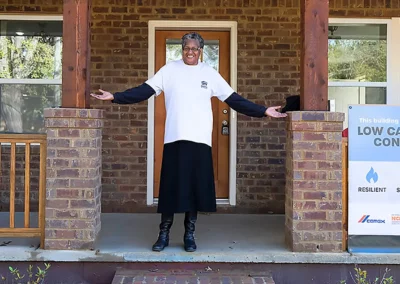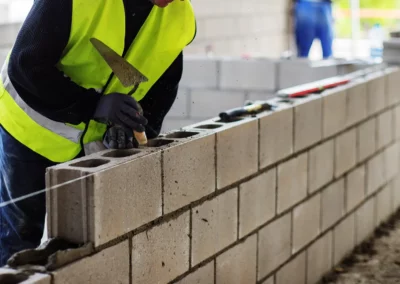We’ve embarked on a crucial stage of our journey: the formal quantification and third-party verification of the impacts of our ultra-low carbon concrete technology.
Because it’s critical that our partners and customers have confidence in our carbon impact, we’re investing heavily in tools and techniques to confirm our results.
First, it’s worth noting that there are two distinct measurements undertaken for structural materials. These are independent calculations performed using different inputs, by different entities, and for different purposes:
- Project emission reductions: This analysis includes “before” and “after” calculations to show CarbonBuilt’s impact on the specific industrial processes that we decarbonize. We use this analysis to generate carbon credits that can be monetized in the carbon markets.
- Product embodied carbon: This analysis results in an Environmental Product Declaration (EPD) for each product type made at a plant. The EPD enables buyers to understand the carbon footprint of CarbonBuilt blocks to meet their specific embodied carbon targets and qualify for government incentives.
We’re in the early stages of the Measurement, Reporting, and Verification (MRV) process to determine our carbon impact at Blair Block, our first commercial retrofit in Childersburg, Alabama.
The MRV outputs will primarily support our participation in the carbon markets, although some variables will also inform our EPDs.
CarbonBuilt and our partners are zeroing in on procedures to perform accurate, ongoing measurements that align with scientific best practices and use industry-standard and carbon registry-approved instrumentation.
What follows is a “state-of-the-state” report, which we’ll update as our process and stakeholder requirements evolve.
Our Approach to MRV in CarbonBuilt’s Ultra-Low Carbon Concrete Technology
To ensure accurate reporting, we track critical variables in our mix design and manufacturing process. MRV applies to two distinct elements of our decarbonization approach:
- Carbon Avoidance: We replace most or all of the carbon-intensive cement in the concrete mix design with low-carbon substitutes, decreasing or even eliminating cement’s associated emissions
- Carbon Removal: We remove CO2 from the atmosphere using direct air capture or waste biomass, then permanently store it in our concrete blocks via mineralization, a form of carbon sequestration
- Note: If non-biogenic industrial CO2 such as flue gas is used as a primary or backup source of CO2, this is considered Carbon Avoidance, not Carbon Removal
Key Calculations for Carbon Credit Buyers
Carbon Avoidance equals the embodied carbon of baseline materials minus the embodied carbon of CarbonBuilt’s substitute materials. “Baseline” refers to the materials and processes that the concrete plant used before CarbonBuilt was involved.
Carbon Removal equals the tonnage of CO2 mineralized minus the incremental process energy needed to deliver the CO2. This is measured primarily via thermo-gravimetric analysis (TGA), in which we grind physical samples of the produced concrete and then quantify the amount of mineralized CO2. We may also measure CO2 inflows and outflows at the curing chambers with flow meters.
We measure the additional energy used by our low carbon concrete process and allocate the associated carbon emissions (typically ~5% of the gross carbon reductions) between removals and avoidance according to the relevant carbon credit registry’s guidance.
We will continue to measure the emissions, avoidances, and removals associated with each plant retrofit every year in order to earn carbon credits.
Our systems and processes will be audited at least annually by a verification/validation body (VVB), a carbon registry-approved auditor who reviews our data and approves it for submission to a registry to award us carbon credits.
Key Calculations for Ultra-Low Carbon Concrete Buyers
We work with Climate Earth to calculate baseline Life Cycle Analysis (LCA) for retrofits.
An LCA takes into account all of the plant’s products, systems, and processes — beyond just those that CarbonBuilt affects at the project level. Information in the LCA includes variables like the energy used to run the production line, waste materials that are unable to be recycled, and much more. From that LCA, Climate Earth derives an EPD for that plant’s traditionally made concrete products.
ClimateEarth then measures those same systems post-retrofit and creates a second EPD to establish the carbon footprint for CarbonBuilt products.
This EPD will be “provisional” for 12 months as EPDs require a full year of historical data before they are official. Both the baseline and the provisional EPDs are validated and certified by a third-party auditor (e.g., ASTM International) to confirm the accuracy of Climate Earth’s calculations.
After a year of production, Climate Earth will review production data and create the official CarbonBuilt EPD. Typical concrete EPDs are valid for 5 years, but Climate Earth has software that will allow us and our producer partners to update the EPDs anytime there is a material change in the ultra-low carbon concrete production process.
Questions We Are Asking About Our MRV & EPD Processes:
CarbonBuilt is always looking at ways to better address the complexities of the MRV and EPD processes, including:
- How can we measure, report and verify better, faster, and more efficiently?
- Are there non-destructive tools to track the carbon removal and compressive strength of our blocks to reduce the volume of finished products diverted for testing instead of real-world use?
- What’s the most effective way to account for background carbonate levels in limestone aggregates?
Thanks for your interest in this topic. The final documentation will take time to publish. In the meantime, if you have any questions or want to learn more, please contact us at info@carbonbuilt.com or sign up for our newsletter for updates.




